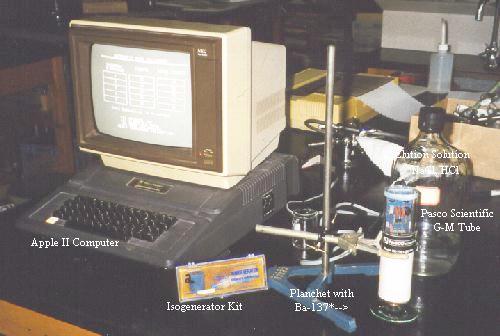
AP Physics Lab
Beta Decay of 137Cs and the half-life of 137Ba* by photon emission
Objective: Determine the half-life (T½) of a radionuclide using the Geiger-Mueller counter.
Introduction
Radionuclides emit various particles and photons during their disintegration. Alpha and beta emitters decay at various rates as characterized by their decay constant, . The relationship between radioactive decay and the data collected in this lab is shown in the equation:
N = No e- lt
where No is the original activity, l is the decay constant, and t is the elapsed time.
Also, it is known that:
T½ = 0.693/ l or l = 0.693/ T½
Hence, if we can measure the original and final activities of the radionuclide, we can calculate the half life and decay constant.
In this lab, 137Cs is the parent nuclide that emits a particle and decays to 137Ba* or 137Ba. The half life of this transition is approximately 30 years. However, the 137Ba* represents a metastable state that eventually emits a photon and becomes 137Ba. It is the half-life of this transition that is the focus of this lab.
Materials: G-M counter, Apple II computer, 137Cs source (Isogenerator Kit)

Methods and Analysis
1. Determine the background radiation (in cpm) over a three minute interval, then convert to counts per 15 second interval.
2. Extract 137Ba* from the 137Cs source following the methods described and place the elution onto a planchet for counting.
3. Record the count every 15 seconds on the computer for approximately 6-8 minutes.
4. Subtract the background count from each value.
5. Graph the counts vs time. Draw a smooth best-fit line.
6. Determine from the graph where the number of counts is ½ the original, then estimate the half life. Compare with the known T½ of 137Ba* (from the Chart of the Nuclides) and calculate a percent error. Discuss the sources of error.
7. Write the entire nuclear decay of 137Cs to 137Ba by beta and gamma photon emission.
8. Calculate the decay constant of the 137Ba transition from the half-life. Compare with two other decay constants.
9. Define decay constant.
10. If the beta particle emitted by 137Cs has a kinetic energy of 0.100 MeV, what is it's velocity and what is the recoil velocity of the 137Cs nucleus?
Back to the Brockport High School Science Department